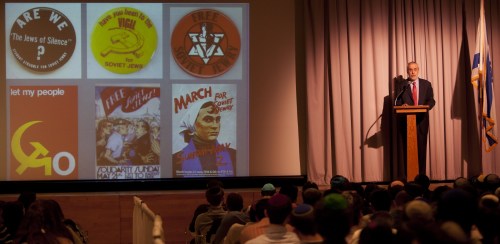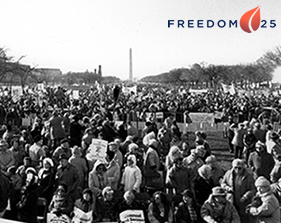Last year, in his blog post on Chanukah, Yossi Prager, AVI CHAI Executive Director – North America, concluded with the following:
“Unlike all other Jewish holidays, Chanukah has no sacred text to be read in synagogue. The Book of Maccabees is part of the Catholic Bible but not the Jewish one, and is largely unknown to most Jews. Instead of public reading, we communicate the story of Chanukah silently, with the act of lighting candles at the window so that Jews and non-Jews alike recognize our celebration of the miracles that occurred. What can parents and Jewish educators learn from this method of teaching about how to inspire others to more active participation in Jewish life and connection to the State of Israel?”
Over the course of this Chanukah, day school educational leaders will shed light on this question here on the blog. Kicking off the holiday, our first response is from Rabbi Jay Goldmintz, Headmaster of Ramaz Upper School.

Above: Rabbi Goldmintz speaking at Ramaz assembly to commemorate the 25th anniversary of the Freedom Sunday March. Photo by Rachel Rabhan.
By: Rabbi Jay Goldmintz, Ed.D
Truth be told, Chanukah candles were originally intended as a message to all of the Jews passing by our window on their way home from the marketplace; the candles, after all, were lit outside the front door opposite the mezuzah. The ideal time to light was thus around dusk. But as work patterns changed and the days got longer, as buildings got taller and the possibility existed that no one would be able to see high enough into one’s window, as anti-Semites posed the risk of vandalism, there was an emphasis on lighting the candles less for passersby than for the people inside one’s own home.
We just recently commemorated the 25th anniversary of the March on Washington, a time when 250,000 Jews gathered from all over the country to advocate on behalf of Soviet Jewry. It is hard to imagine a country like the Soviet Union with close to 3 million Jews and yet without any Judaism. No schools or Hebrew teachers or kosher food or brit milah. A modern day Chanukah story, Jews had long since assimilated and the light of Judaism was nearly snuffed out. And yet, thanks to the extraordinary, near miraculous, courage of a small number of Maccabees, Jewish life began to come alive in the refusenik community.
For our part, the Soviet Jewry movement represented a kind of coming of age for the community. Wracked by a certain amount of guilt and shame for fear that not enough had been done on behalf of Jews in the Shoah, the community was determined not to let it happen again. It didn’t happen overnight, however. As is so often the case, it began with a small group of people, primarily students, who decided to speak out. Thanks to their efforts, combined with a host of other factors, the spark of protest lit a fire that spread internationally. There were annual protests and marches, petitions and lobbying and, most important, there was a growing sense of pride in the community as we found our individual and collective Jewish voice. It proved that we could stand up for our Jewishness, that we could impact the American political system and world politics and do so while asserting our Jewish identities. The movement was thus about fighting for the freedom of Soviet Jews from external oppression even as it meant we were fighting for freedom from our own self-imposed silence and insecurity. The cry “Never again” had different meanings internally and externally.
Freedom Sunday March. Photo by freedom25.net
And yet, in at least one way the movement was a failure. As Natan Sharansky has said, and as the organization Freedom25.net is trying to convey, a generation of Jews spent 10, 15, 20 years or more fighting a battle that we ultimately won and yet, amazingly, we failed to tell our children about it. Our kids for the most part have no idea of our struggles or those of Soviet Jews, they have no idea what it meant to take to the streets, work the system, and change the world. And they do not know the story because quite simply we haven’t shared it with them. At our own recent commemoration of this event, a guest asked a group of 14-year-olds if they had ever been to a rally; none had. And the only petition anyone had signed was to protest the cancellation of her favorite TV show. The fault for this lack of involvement and lack of knowing their own history lies with us.
Perhaps the first lesson of those Chanukah candles, then, is that they should not stand silent but that inside our own homes we need to tell their story, our story, our chronicles about the Maccabees of yore, and the Maccabees of Israel’s War of Independence and of Soviet Jewry. We need to tell our kids what these stories mean to us, including what we have accomplished as individuals and as a community and as a people. We need to share with them our pride and not assume that they just “get it” by osmosis or will learn about it one day. They may not, and so we must teach it to them explicitly and purposefully.
The second lesson is that, as regards the outside world, we need to tell our kids that they need to stand up and be counted. They need to take an interest in the events beyond themselves and to dedicate themselves to sending the message that they will not allow the darkness of anti-Semitism or oppression of any people to go unchallenged. We need to teach them that they indeed have the power to change the world and to fulfill our national destiny to be a light unto the nations.
Rabbi Jay Goldmintz, Ed.D., is Headmaster of Ramaz Upper School.

